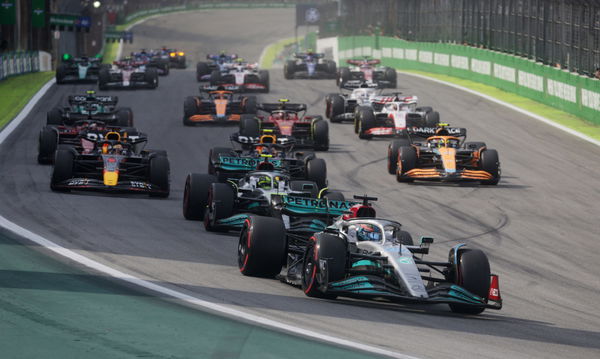
via Reuters
Formula One F1 – Brazilian Grand Prix – Jose Carlos Pace Circuit, Sao Paulo, Brazil – November 13, 2022 Mercedes’ George Russell leads at the start of the race REUTERS/Ricardo Moraes

via Reuters
Formula One F1 – Brazilian Grand Prix – Jose Carlos Pace Circuit, Sao Paulo, Brazil – November 13, 2022 Mercedes’ George Russell leads at the start of the race REUTERS/Ricardo Moraes
A typical Formula 1 race lasts around 300 km (186 miles). During the race, an F1 car consumes almost 240 lbs of fuel limit set by the FIA. If a typical road car were to cover that distance in a similar race, it would use less than 1/3rd of that fuel. That is despite the fact that F1 engines are often regarded as ultra-efficient workhorses. What makes those heavyweight power units deliver to the best of their ability is the fuel that goes in them. But the chemicals used in F1 fuel are the same as the fuel commercially available for road cars. Then what is it that separates the two? Let’s find out without.
Working towards its commitment to the environment and safety of the drivers, FIA regulates the chemical composition of the fuel used in F1 cars. Over the course of the last few years, many changes have come in, including the use of unleaded fuel.

via Reuters
Formula One F1 – Abu Dhabi Grand Prix – Yas Marina Circuit, Abu Dhabi, United Arab Emirates – November 18, 2022 Ferrari’s Carlos Sainz Jr. and Red Bull’s Sergio Perez in action during practice REUTERS/Leonhard Foeger
While the FIA regulates the composition of chemicals in the fuel, it gives ample freedom to the teams to get creative and innovate. This is where the researchers are free to find the blend that works best for their car’s engine. That, however, brings down the fuel economy. A typical road car in the UK has a fuel economy of 38 mpg. Whereas, an F1 car, which can cost as high as $16 million (as per Red Bull’s official website) can only deliver at around 6.2 mpg, at most, 7 mpg on a race track like Monaco.
ADVERTISEMENT
Article continues below this ad
In 2021, Mercedes devised a clever technique, later copied by others, to derive the best thermal efficiency from their power units. Thermal efficiency simply explained is how much of the energy in the fuel is actually being used to push the car forward. Mercedes, according to former British driver Scott Mansell, was able to derive 50% thermal efficiency. In comparison, road cars don’t get more than 30% efficiency.
How the FIA keeps fuel regulations in check
Before the start of each season, every team submits a fuel sample they would be running their cars on. The fuel, needless to say, has to comply with the regulations in place for the particular season. Later, as the season progresses, the ruling body conducts surprise inspections where they take fuel randomly during a race weekend. The fuel is then tested in a lab with a technique called gas chromatography. The tested fuel has to match the chemical components with the sample submitted earlier.
In 1997, Mika Hakkinen‘s car was found to be running on fuel different from that of the sample. Resultantly, he had his P3 finish at Spa taken away.
Read More: Ferrari, Mercedes & Audi Gang Up on Red Bull to Take Away a Covered F1 Privilege
Way back in 1976, McLaren and Penske’s cars were found to have octane mixtures that were too high. Their cars were pushed to the back of the grid after the conclusion of the Italian GP.
Why keeping fuel composition in check is important for the safety of drivers
Generally speaking, leaner fuel produces more energy. However, there is a big downside to it, as it produces massive amounts of heat as well. Before the FIA started regulating fuel, constructors used leaner fuel and we would often see cars catching fire. Sometimes the fire was so massive that it almost looked like a fireball.

via Reuters
Formula One F1 – Mexico City Grand Prix – Autodromo Hermanos Rodriguez, Mexico City, Mexico – October 30, 2022 Mercedes’ Lewis Hamilton in action ahead of Red Bull’s Sergio Perez after the start of the race REUTERS/Henry Romero
To ensure that does not happen anymore, not only is chemical composition kept in check but also the way cars store it. Nowadays, cars have fuel bags and not fuel tanks. These bags are situated right behind the driver’s seat. However, they are still prone to come in contact with parts such as brakes and exhaust that get extremely hot during a race. To prevent any untoward incident from happening, the fuel bag is made using ballistic-grade material which can take a beating, according to former McLaren engineer Marc Priestley. Despite big crashes, it does not pierce and spill fuel around. Romain Grosjean’s fiery crash during the 2020 Bahrain GP proved that wrong.
ADVERTISEMENT
Article continues below this ad
Fuel changes in the upcoming F1 season
The 2023 season will have a host of changes. Big changes include the increase in ride height by 15 mm and a stiffer floor. Taking note of the horrific crash that Zhou Guanyu had in 2022, sturdier roll hoops will come in place as well.
In terms of fuel, teams will have a little more freedom when it comes to storage. In races where the ambient temperatures will be less than 30 degrees Celsius (86 degrees Fahrenheit), teams can cool the fuel down up to 10 degrees Celsius (50 degrees Fahrenheit). Moreover, a relief valve will be installed in the cars to ensure that the pressure does not exceed 1 bar.
ADVERTISEMENT
Article continues below this ad
Watch This Story: Most Dangerous Crashes in F1 History
What do you think about the complex brainstorming that goes into the fuel dynamics in F1? A pretty interesting and integral part of the car, isn’t it?
ADVERTISEMENT
ADVERTISEMENT
ADVERTISEMENT
ADVERTISEMENT

